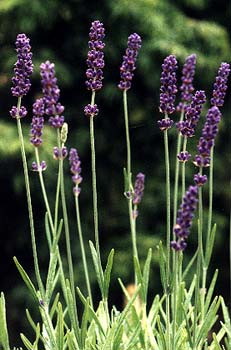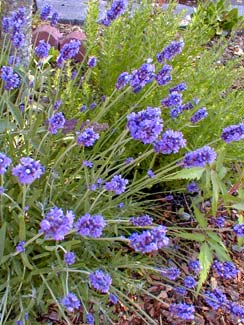
Dwarf Hidcote Lavender
With Instructions for Brewing
Josephine Bonaparte's
Aphrodisial Lavender Mocha
"No wonder that she kept her figure slim
And always made you think of lavender."
-Edwin Arlington Robinson
(1869‚1935)
(1869‚1935)
'Hidcote' is a selected dwarf variety of common lavender, a highly aromatic sub-shrub with a brilliant flower-spike of the brightest dark purple. Hidcote which is a darker shade than other varieties tends toward navy blue. It is thus sometimes designated 'Hidcote Blue.' There is also a 'Hidcote Pink.' There is additionally a non-dwarf strain, 'Hidcote Giant.'
Dwarf 'Hidcote' is propogated by cuttings or division. Specimens grown from seed are not entitled to the cultivar name 'Hidcote.' It received the Award of Garden Merit in 1993, reconfirmed after new trials in 2001.
Variously called French Lavender, True Lavender, English Lavender, or Common Lavender, it is native of the entire Mediterranean regions to as far north as Switzerland.
Hidcote's steam-distilled flowers provide the purest of all lavender scents for soaps, cosmetics & perfumes. Its use as a toiletry scent is ancient, & the very word lavender means "to wash." The species name angustifolium means "narrow-leafed," though it is often mispelled augustifolium which means "supreme-leafed" which is a pretty good name too.
 True lavender is called "Queen of the Herbs" since it matches usefulness with beauty & provides one of the most pleasing of all garden scents. It is a major source of essential oils, being one of the sweetest smelling of the lavenders.
True lavender is called "Queen of the Herbs" since it matches usefulness with beauty & provides one of the most pleasing of all garden scents. It is a major source of essential oils, being one of the sweetest smelling of the lavenders.In the roadside sun-garden, the long-lasting flowers begin to be numerous in June. These blooms will be around until Autumn if deadheaded, having a bright present at least until the first frosts in Autumn.
The odor delights more than people, as it is one of the first choice blooms for butterflies & bees. Dried flowers retain their scent a long while & are most commonly used in sachets. The sweet odor was long belived to ward off illness, so that lavender was one of the key ingredients in dried-flower bouquets known as "tussie mussies" used since the Dark Ages to ward off plague or bad luck. As a medicinal, the essential oils can ease the itch of insect bites.
Most lavender varieties grow larger than Hidcote, but there are also dwarf forms that are much smaller. Hidcote grows in an upright clump eight inches to a foot in height, with its many flowerspikes raising the height to 18 inches or two feet. Occasionally the spikes are not fully upright, but lean toward the direction of the sun when it is at its brightest. The first photo shows it in July 2002 when it was still quite a young clump. The second photo from June 2003 has behind it a clump of Dwarf Blue Hyssop.
It wants full sun for a sizeable percentage of the day & once established requires very little watering or attention. It is drought tolerant & will thrive in fairly dry soil, though evenly moist well-drained soils are better still & it is not quite as neglectable as Spanish Lavender. It wants little or no fertilizing, preferring a sandy medium.
Either in the Fall when it is finished blooming, or in early spring before it comes out of dormancy, it benefits from being sheared back by about one-third. Early spring is perhaps best as it provides a nice semi-evergreen presence during the winter. If it is never sheared at all it will get leggy over time, even though Hidcote is naturally more compact than other varieties.
The flower is edible & can be crystalized in sugar as a cake decoration. It is excellent as a flavoring for jams, jellies, & syrups, or for pastries & candy. Take freshly dried flowers, pound them in a mortar, & add to powdered sugar. This can be sprinkled on cookies or pies or on breakfast waffles or crepes. It also makes a nice ingredient for home-made vanilla icecream, not so much altering the flavor as lending it a marvelously tempting odor. Lavender is also used as a spice on chicken & meats, though the more comphorish-scented Spanish Lavender is perhaps preferable for the radically unkosher who would eat porkroast.
Lavender also makes a soothing nighttime tea. Three dried flowerheads will brew one cup, or one flowerhead mixed with camomille will give boring night-time camomille a flavorful boost. For morning tea add two or three whole lavender flowers to a pot of steeping Earl Grey.
True Lavender also provided Napoleon & Josephine with their best-loved aphrodisiac. Josephine to maintain the sexual interest of Napoleon would have him brought a drink made from lavender & chocolate. This became his favorite drink.
Here's how to make Josephine Bonaparte's Hot-to-Trot Aphrodisial Lavender Mocha: Prepare in a drip-coffee maker one part fresh ground coffee to three parts crunched up fresh (or dried) lavender flowers. Calculate the amount by assuming approximately one tablespoon coffee & three tablespoons lavender for each cup of coffee made. Prepare an equal amount bittersweet hot cocoa separately. Mix together. Optionally, add a thimble or so of cocoa liquor. You won't be sorry.